Race Design Challenge
Page 12 - Get up to date with the latest news, scores & standings from the Cycling News Community.
You are using an out of date browser. It may not display this or other websites correctly.
You should upgrade or use an alternative browser.
You should upgrade or use an alternative browser.
- Jul 24, 2014
- 150
- 0
- 0
Giro di Stromeon Stage 16: Merano - Bormio 209km
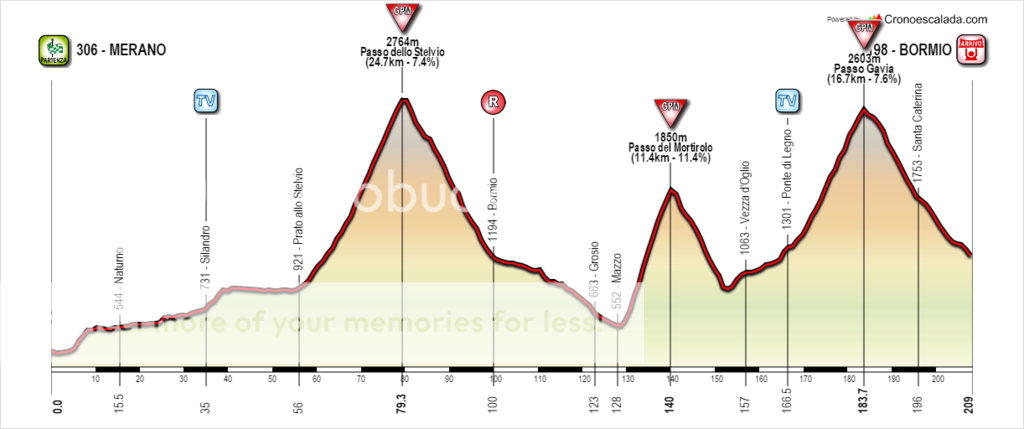

I'm not going to be able to do this stage justice in the time that I have to do the write-up, so It won't be the full-on history report and scenery goggling we had in the last two mountain stages, but I'll try my best to do a decent short write-up!
After a well-deserved rest day, the riders will transfer across from Cortina to Merano, an important town in the Italian Alps and a Giro host town a number of times, and will tackle three of the Giro's greatest climbs, all from their most difficult side. The first of those is the legendary Passo dello Stelvio, the Cima Coppi of the Giro di Stromeon, tackled, unlike in 2012 and 2014, from the east, the famous hairpin side. Almost 25km at 7.4% is an absolutely mammoth challenge, last tackled from this side in the Giro in 2005. The Stelvio has gained a mythical status in Giro history, due to its length, difficulty and drama both in the scenery and on the road. Witness the famous picture that Brullnux posted above of the riders hauling their bikes through the snow, and of Coppi's epic victory. Right up until its most recent appearance in 2014, the Stelvio has never failed to offer a spectacle (even in 2012, when all other climbs were sullied by that awful race, Thomas de Gendt saved us from the boredom that was going on behind). Today, however, the Stelvio is a long way from the finish, but a 100th Giro would be incomplete without what is arguably the Giro's greatest climb, it just simply has to be there.
We rush down the descent into Bormio, where the race finishes. But not just yet. There's the small matter of two more Giro giants to tackle before we return to this scenic Alpine town. Next up: the Mortirolo. Tackled from the traditional Mazzo side, the Mortirolo is also a climb that rarely fails to deliver, and its incredible steepness makes for agonising cycling for the riders but amazing viewing for the spectators. The Mortirolo has produced so many epic stages I don't have time to go into detail, but I'm sure memories of Pantani, Gotti, Basso and the like are swimming around in everyone's head. And yes, I can hear you at the back there, screaming at me that the Mortirolo is miles away from the finish and I'm not using this legendary climb well. Well, I am perhaps inclined to agree, but the facts are this: there are not many more mountains after this stage, and no time-trial either, and so if riders want to make up big amounts of time, then this is the stage to do it. We're coming out of a rest day, so there will be riders who, shall we say, come out of the rest day with an extra spring in their step, and others who don't, and so if this Giro is being aggressively raced I see no reason why someone might not attack on the Mortirolo.
After the Mortirolo there is some false flat to be tackled, but not much at all before we're onto the Gavia. I had so many different ideas for this stage that it took me a long time to decide which one I wanted to use, and I decided to go for this stage because a) I thought Mortirolo-Aprica would feature in most of the other Giri (my hypothesis seems to be correct so far), and we will also have only had it two years previously, and b) a descent finish off the Gavia offers the ultimate tribute to perhaps the Giro's most famous stage ever, that stage in 1988 into Bormio in the blizzard. Added to that, a descent finish will work on this stage as it comes both after a rest day and after the hardest mountains in the race, so the riders should not be saving their energy for later on. Thus we tackle the Gavia from Ponte di Legno, as in 1988. The riders will probably be hoping that the weather is better than then, but I for one certainly wouldn't mind if it wasn't! The Gavia is the third of the three monoliths tackled today, and has, apart from the Hampsten madness, always been a little in the Stelvio's shadow (while still being one of the most iconic Giro climbs, of course), and so I think it deserves the prominence it's getting in my 100th Giro as the focal point of this epic stage. Slightly steeper than the Stelvio, but a bit shorter, it is nevertheless very much hors catégorie! The descent down into Bormio is very rapid, and also pretty technical in places, providing an opportunity for excellent descenders to make, or make up, time according to the situation. Whatever it is, one thing is sure: time gaps. Massive ones.
This could be a very special stage.
Merano:
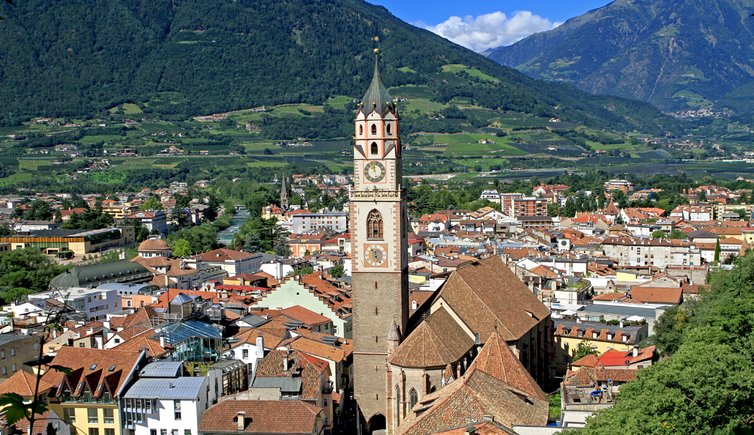
Passo dello Stelvio:
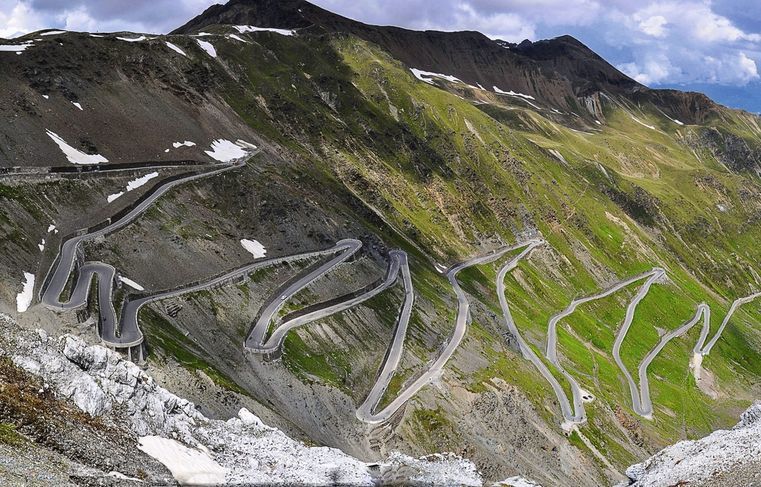
Bormio:



I'm not going to be able to do this stage justice in the time that I have to do the write-up, so It won't be the full-on history report and scenery goggling we had in the last two mountain stages, but I'll try my best to do a decent short write-up!
After a well-deserved rest day, the riders will transfer across from Cortina to Merano, an important town in the Italian Alps and a Giro host town a number of times, and will tackle three of the Giro's greatest climbs, all from their most difficult side. The first of those is the legendary Passo dello Stelvio, the Cima Coppi of the Giro di Stromeon, tackled, unlike in 2012 and 2014, from the east, the famous hairpin side. Almost 25km at 7.4% is an absolutely mammoth challenge, last tackled from this side in the Giro in 2005. The Stelvio has gained a mythical status in Giro history, due to its length, difficulty and drama both in the scenery and on the road. Witness the famous picture that Brullnux posted above of the riders hauling their bikes through the snow, and of Coppi's epic victory. Right up until its most recent appearance in 2014, the Stelvio has never failed to offer a spectacle (even in 2012, when all other climbs were sullied by that awful race, Thomas de Gendt saved us from the boredom that was going on behind). Today, however, the Stelvio is a long way from the finish, but a 100th Giro would be incomplete without what is arguably the Giro's greatest climb, it just simply has to be there.
We rush down the descent into Bormio, where the race finishes. But not just yet. There's the small matter of two more Giro giants to tackle before we return to this scenic Alpine town. Next up: the Mortirolo. Tackled from the traditional Mazzo side, the Mortirolo is also a climb that rarely fails to deliver, and its incredible steepness makes for agonising cycling for the riders but amazing viewing for the spectators. The Mortirolo has produced so many epic stages I don't have time to go into detail, but I'm sure memories of Pantani, Gotti, Basso and the like are swimming around in everyone's head. And yes, I can hear you at the back there, screaming at me that the Mortirolo is miles away from the finish and I'm not using this legendary climb well. Well, I am perhaps inclined to agree, but the facts are this: there are not many more mountains after this stage, and no time-trial either, and so if riders want to make up big amounts of time, then this is the stage to do it. We're coming out of a rest day, so there will be riders who, shall we say, come out of the rest day with an extra spring in their step, and others who don't, and so if this Giro is being aggressively raced I see no reason why someone might not attack on the Mortirolo.
After the Mortirolo there is some false flat to be tackled, but not much at all before we're onto the Gavia. I had so many different ideas for this stage that it took me a long time to decide which one I wanted to use, and I decided to go for this stage because a) I thought Mortirolo-Aprica would feature in most of the other Giri (my hypothesis seems to be correct so far), and we will also have only had it two years previously, and b) a descent finish off the Gavia offers the ultimate tribute to perhaps the Giro's most famous stage ever, that stage in 1988 into Bormio in the blizzard. Added to that, a descent finish will work on this stage as it comes both after a rest day and after the hardest mountains in the race, so the riders should not be saving their energy for later on. Thus we tackle the Gavia from Ponte di Legno, as in 1988. The riders will probably be hoping that the weather is better than then, but I for one certainly wouldn't mind if it wasn't! The Gavia is the third of the three monoliths tackled today, and has, apart from the Hampsten madness, always been a little in the Stelvio's shadow (while still being one of the most iconic Giro climbs, of course), and so I think it deserves the prominence it's getting in my 100th Giro as the focal point of this epic stage. Slightly steeper than the Stelvio, but a bit shorter, it is nevertheless very much hors catégorie! The descent down into Bormio is very rapid, and also pretty technical in places, providing an opportunity for excellent descenders to make, or make up, time according to the situation. Whatever it is, one thing is sure: time gaps. Massive ones.
This could be a very special stage.
Merano:

Passo dello Stelvio:

Bormio:

- Jun 24, 2013
- 3,548
- 1,079
- 16,680
5.2 5.5Km
Giro d'Italia - Stage 16: Parma - Genoa (208 km)

The race has travelled to Parma during the rest day and thus there starts the 3rd week. It's easy goings on Stage 16 with a flattish route giving the sprinters one of their best opportunities.The only hill on the route (5.5 km @5.2%) is placed in the middle of the stage and should be of little importance.

Start town Parma is mostly known for it's role in the food industry. Everyone knows Prosciutto di Parma and Parmesan cheese but also Parmalat, one of the biggest dairy companies in the world.
Finish is in Genoa, capital of Liguria. Located at the Mediterranean, it hosts the biggest port in Italy. It's historic centrewith all it's narrow alleys is part of Unesco world heritage and worth a visit.
Giro d'Italia - Stage 16: Parma - Genoa (208 km)

The race has travelled to Parma during the rest day and thus there starts the 3rd week. It's easy goings on Stage 16 with a flattish route giving the sprinters one of their best opportunities.The only hill on the route (5.5 km @5.2%) is placed in the middle of the stage and should be of little importance.

Start town Parma is mostly known for it's role in the food industry. Everyone knows Prosciutto di Parma and Parmesan cheese but also Parmalat, one of the biggest dairy companies in the world.
Finish is in Genoa, capital of Liguria. Located at the Mediterranean, it hosts the biggest port in Italy. It's historic centrewith all it's narrow alleys is part of Unesco world heritage and worth a visit.
- Feb 20, 2010
- 33,095
- 15,343
- 28,180
Stage 16: Bergamo - Como, 159km

Much like Finn and barmaher, I am seemingly a stage in front of some of you regarding the mountains, as I did Mortirolo-Aprica before the rest day, so I am opening week 3 with a tribute to the Giro di Lombardia and the Race of the Falling Leaves' iconic status in the history of Italian cycling.
This stage was also designed before the route for the 2015 Giro di Lombardia was announced, as I felt that I wanted to restore some of the glories of the route I enjoyed most in the race in recent years as opposed to the somewhat disappointing recent routes (from 2011 to 2014), only to now find that the actual race is doing the same thing, and so my stage will be an inferior shorter version. Not that it was meant to be a long stage, as given that it comes after the rest day and with tomorrow's stage in mind, I am anticipating this to be one that goes to the break much as, say, the 2011 stage to Tirano, where there are big and iconic climbs that produce a potential GC banana skin but where the escape is likely to produce the majority of the action.

The stage could be very short, but there's an early detour to the small town of Sedrina, the hometown of one of Italy's all time greatest, the legendary Felice Gimondi. Gimondi's legacy in Italian cycling is enormous, and as one of the very rare men indeed to win the Tour de France as a neo-pro (not that that really meant the same then as now) he's very much an icon to commemorate. One of the few to win all of the Grand Tours, he holds the record for the most podiums at the Giro (nine in all), including three wins spread over a decade, and also won Lombardia, the race the stage is based around, twice as well.
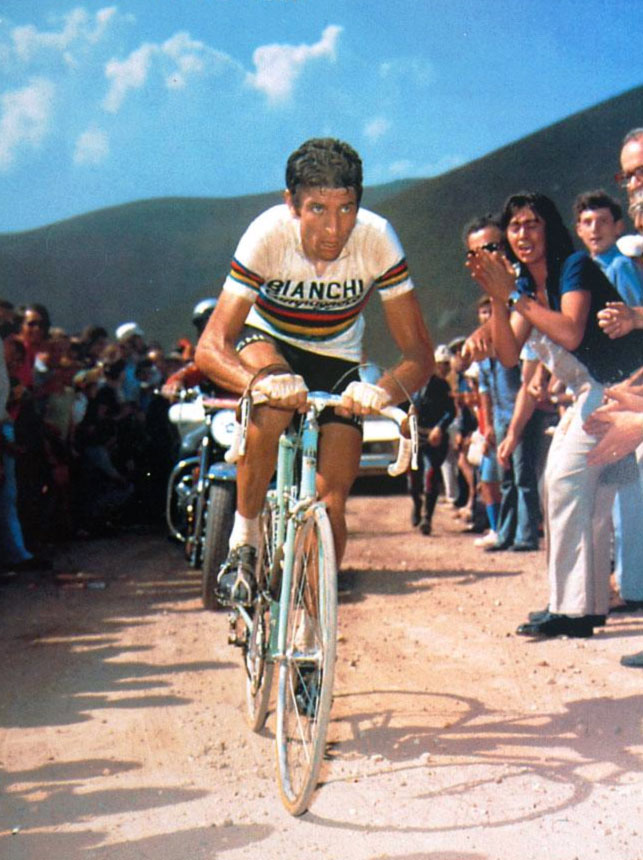
After that little loop, the route rumbles around the terrain of the Giro di Lombardia, taking in key note climbs of recent years. No Valcava because of having to climb the wrong side of it, and also to humanize the race a bit more; the first climb is the steep Villa Vigevano climb that characterized the 2011-13 route (and neutralized all the early climbing as a result too). This helpful graphic includes most of the climbs of the day:

Villa Vigevano is unlikely to cause much trouble before a loop around Lecco and then towards the northern edge of the Lago di Como, passing stunning scenery along the way. Barmaher has already posted tribute to the Madonna del Ghisallo, so it's my turn to tone it down to allow them to take centre stage, as with its legendary history there's not much for me to add... except to hype up the obvious awesomeness of the last person to triumph in a stage finishing at Ghisallo:

Anyway, Ghisallo with its legendary slopes and sights comes with 53km remaining. From that it's straight into the Colma di Sormano via the Muro, again the legend of which has been eloquently put forward already. I have gone to the trouble of mapping this section by hand to make sure the profile is accurate, because that was before Google decided to break what was already broken just a little bit more. The Muro crests 40km from the stripe and means that the breakaway should be broken up by this survival climb; behind, anybody who is having a bad day could really suffer here and will have to work very hard on the technical descent and subsequent flat - again along the beautiful scenery of Lake Como - to get back on, effort they are likely to pay for tomorrow.
As this isn't a Classic in its own right, however, and there are tough days to come, the lead-in is easier than the 2015 Lombardia route, with no Civiglio climb and just the loop of San Fermo di Battaglia as per the pre-2011 route; though it's just 3km long with a max of 8,2% its proximity to the finish means that we could well see a fight for seconds given that the burst needed is comparatively short and won't adversely affect the legs for the coming stages as much as an early attack; however if a contender is feeling bad and has had to fight to get back on after losing touch on the Muro, responding to moves here could be an issue. This is likely to be fought out by the break, but the GC men can't totally take their eyes off the ball, that's for sure.


Much like Finn and barmaher, I am seemingly a stage in front of some of you regarding the mountains, as I did Mortirolo-Aprica before the rest day, so I am opening week 3 with a tribute to the Giro di Lombardia and the Race of the Falling Leaves' iconic status in the history of Italian cycling.
This stage was also designed before the route for the 2015 Giro di Lombardia was announced, as I felt that I wanted to restore some of the glories of the route I enjoyed most in the race in recent years as opposed to the somewhat disappointing recent routes (from 2011 to 2014), only to now find that the actual race is doing the same thing, and so my stage will be an inferior shorter version. Not that it was meant to be a long stage, as given that it comes after the rest day and with tomorrow's stage in mind, I am anticipating this to be one that goes to the break much as, say, the 2011 stage to Tirano, where there are big and iconic climbs that produce a potential GC banana skin but where the escape is likely to produce the majority of the action.

The stage could be very short, but there's an early detour to the small town of Sedrina, the hometown of one of Italy's all time greatest, the legendary Felice Gimondi. Gimondi's legacy in Italian cycling is enormous, and as one of the very rare men indeed to win the Tour de France as a neo-pro (not that that really meant the same then as now) he's very much an icon to commemorate. One of the few to win all of the Grand Tours, he holds the record for the most podiums at the Giro (nine in all), including three wins spread over a decade, and also won Lombardia, the race the stage is based around, twice as well.

After that little loop, the route rumbles around the terrain of the Giro di Lombardia, taking in key note climbs of recent years. No Valcava because of having to climb the wrong side of it, and also to humanize the race a bit more; the first climb is the steep Villa Vigevano climb that characterized the 2011-13 route (and neutralized all the early climbing as a result too). This helpful graphic includes most of the climbs of the day:

Villa Vigevano is unlikely to cause much trouble before a loop around Lecco and then towards the northern edge of the Lago di Como, passing stunning scenery along the way. Barmaher has already posted tribute to the Madonna del Ghisallo, so it's my turn to tone it down to allow them to take centre stage, as with its legendary history there's not much for me to add... except to hype up the obvious awesomeness of the last person to triumph in a stage finishing at Ghisallo:

Anyway, Ghisallo with its legendary slopes and sights comes with 53km remaining. From that it's straight into the Colma di Sormano via the Muro, again the legend of which has been eloquently put forward already. I have gone to the trouble of mapping this section by hand to make sure the profile is accurate, because that was before Google decided to break what was already broken just a little bit more. The Muro crests 40km from the stripe and means that the breakaway should be broken up by this survival climb; behind, anybody who is having a bad day could really suffer here and will have to work very hard on the technical descent and subsequent flat - again along the beautiful scenery of Lake Como - to get back on, effort they are likely to pay for tomorrow.
As this isn't a Classic in its own right, however, and there are tough days to come, the lead-in is easier than the 2015 Lombardia route, with no Civiglio climb and just the loop of San Fermo di Battaglia as per the pre-2011 route; though it's just 3km long with a max of 8,2% its proximity to the finish means that we could well see a fight for seconds given that the burst needed is comparatively short and won't adversely affect the legs for the coming stages as much as an early attack; however if a contender is feeling bad and has had to fight to get back on after losing touch on the Muro, responding to moves here could be an issue. This is likely to be fought out by the break, but the GC men can't totally take their eyes off the ball, that's for sure.

- Oct 12, 2013
- 2,430
- 31
- 6,530
Re:

Openrunner also has the Streetview button in the right bottom corner now, which is idiotic. The button to get out of Streetview is in the top left corner. Makes sense, no? Zooming still works though without problems, i guess i should be happy about that.
It's called crapification.Libertine Seguros said:My actual stage will follow, but for the moment, I just want to have a bit of a rant about how much I **** hate google maps now. They seem to be hell-bent on ruining everything that utilises their client.
Openrunner also has the Streetview button in the right bottom corner now, which is idiotic. The button to get out of Streetview is in the top left corner. Makes sense, no? Zooming still works though without problems, i guess i should be happy about that.
- Mar 24, 2011
- 10,527
- 1,927
- 25,680
Judge 1:
Brullnux T: 4/5 C: 4/5 (A very good Mortirolo stage)
Barmaher T: 3/5 C: 2/5 (A good hilly stage)
Gigs_98 T: 4/5 C: 3/5 (You should have used Sampeyre, it's after a restday and you can always make the next day easier)
Billie T: 2/5 C: 5/5 (A normal sprint stage, but I really like the whole region)
Finn84 T: 2/5 C: 3/5 (I'm not the biggest fan of those kind of stages, but at least it's a long stage)
Libertine: T: 3/5 C: 2/5 (Another nice hilly stage)
Stromeon T: 5/5 C: 4/5 (That's an awesome stage, it would be great to watch)
Judge 2:
Brullnux T:4/5 C:3/5 (nice Mortirolo stage)
Barmaher T:4/5 C:4/5 (good Lombardy tribute)
Gigs98 T:3/5 C:2/5 (solid mountain stage)
Billie T: 2/5 C:5/5 (decent transition)
Finn84 T:2/5 C:2/5 (shame its only the single MTF)
Libertine T:3/5 C:4/5 (another good Lombardy tribute)
Stromeon T:5/5 C:3/5 (Stelvio/Mortirolo/Gavia WOW!!)
Judge 3:
Brullnux T:5/5 C:3/5 (Stelvio, Gavia, Mortirolo, Aprica...)
Barmaher T:3/5 C:4/5
Gigs98 T:4/5 C:2/5 (that's the best option to use Sestriere from the west)
Billie T: 2/5 C:2/5
Finn84 T:2/5 C:1/5 (Not even up to the top of the Colma?)
Libertine T:3/5 C:4/5
Stromeon T:4/5 C:3/5 (I knew someone was gonna come up with this stage... it's great but I like Brullnux's better)
GC after stage 16:
Barmaher 397
Gigs 392
Libertine 391
Stromeon 387
Brullnux 375
Billie 339
Finn 278
REVISED GC after stage 16:
Barmaher 418
Libertine 413
Stromeon 411
Gigs 409
Brullnux 396
Billie 357
Finn 291
Brullnux T: 4/5 C: 4/5 (A very good Mortirolo stage)
Barmaher T: 3/5 C: 2/5 (A good hilly stage)
Gigs_98 T: 4/5 C: 3/5 (You should have used Sampeyre, it's after a restday and you can always make the next day easier)
Billie T: 2/5 C: 5/5 (A normal sprint stage, but I really like the whole region)
Finn84 T: 2/5 C: 3/5 (I'm not the biggest fan of those kind of stages, but at least it's a long stage)
Libertine: T: 3/5 C: 2/5 (Another nice hilly stage)
Stromeon T: 5/5 C: 4/5 (That's an awesome stage, it would be great to watch)
Judge 2:
Brullnux T:4/5 C:3/5 (nice Mortirolo stage)
Barmaher T:4/5 C:4/5 (good Lombardy tribute)
Gigs98 T:3/5 C:2/5 (solid mountain stage)
Billie T: 2/5 C:5/5 (decent transition)
Finn84 T:2/5 C:2/5 (shame its only the single MTF)
Libertine T:3/5 C:4/5 (another good Lombardy tribute)
Stromeon T:5/5 C:3/5 (Stelvio/Mortirolo/Gavia WOW!!)
Judge 3:
Brullnux T:5/5 C:3/5 (Stelvio, Gavia, Mortirolo, Aprica...)
Barmaher T:3/5 C:4/5
Gigs98 T:4/5 C:2/5 (that's the best option to use Sestriere from the west)
Billie T: 2/5 C:2/5
Finn84 T:2/5 C:1/5 (Not even up to the top of the Colma?)
Libertine T:3/5 C:4/5
Stromeon T:4/5 C:3/5 (I knew someone was gonna come up with this stage... it's great but I like Brullnux's better)
GC after stage 16:
Barmaher 397
Gigs 392
Libertine 391
Stromeon 387
Brullnux 375
Billie 339
Finn 278
REVISED GC after stage 16:
Barmaher 418
Libertine 413
Stromeon 411
Gigs 409
Brullnux 396
Billie 357
Finn 291
- Mar 24, 2011
- 10,527
- 1,927
- 25,680
well, ***. You're right. I kinda forgot because that rule was initially planned to give more importance to the whole route, when the technical rating was meant to be every time an evaluation of the route up to that point. Now it's a bit meaningless tbh. But I never announced that the rule was gonna drop, so at this point it'll stay. I'll remake the calculations also for stage 15Gigs_98 said:Well Eshnar, I dont want to spoil your calculations, but wasnt it a rule that in the last 7 stages the technical rating will be worth double?
- Sep 1, 2010
- 1,536
- 391
- 11,180
Stage 17, Bergamo - Passo dello Stelvio, 238 km


Well, after a long stage another very long stage awaits the riders. This time it's much more tougher, including Gavia and Stelvio, the latter which hosts the finish. While it has been climbed several times in recent years, only once it has hosted a finish: in 2012 when Thomas de Gendt won. That stage didn't include Gavia though.
The riders start from Bergamo and climb past a rarer mountain Passo San Marco (20.1/7.2%) which won't make big decisions other than form a gruppetto. After a flat section via Sondrio the serious stuff begins.
Passo d'Aprica (13.6/5.9%) is not very high but still a traditional climb in Giro. It will be soon followed with Gavia (17.7/7.1%) and Stelvio (21.2/7.3%). Gavia is more difficult from the south while Stelvio is probably tougher to climb from elsewhere. However, double makes it more demanding for the riders anyway.
Stelvio will be Cima Coppi climb of the Giro.
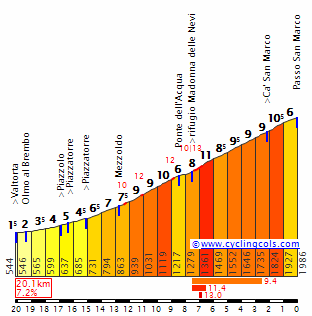

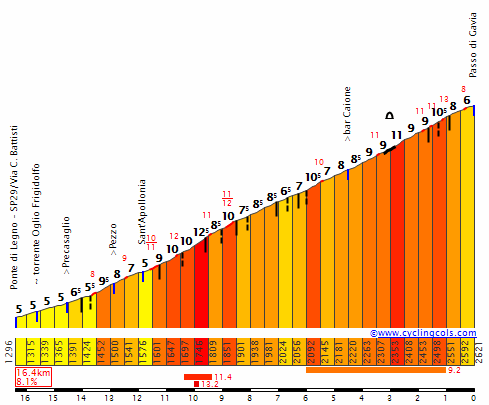
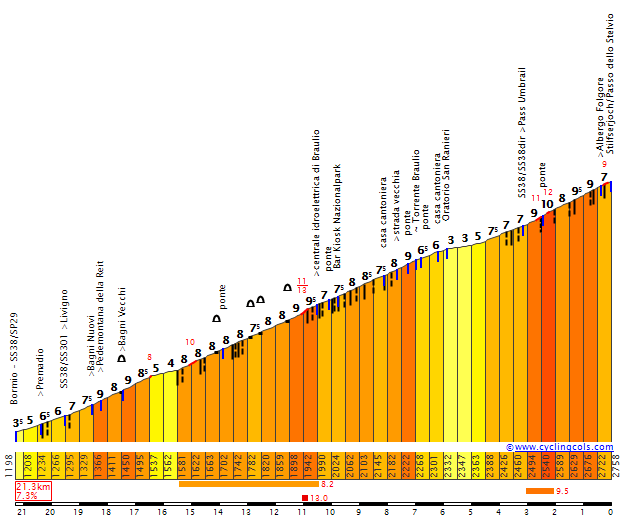


Well, after a long stage another very long stage awaits the riders. This time it's much more tougher, including Gavia and Stelvio, the latter which hosts the finish. While it has been climbed several times in recent years, only once it has hosted a finish: in 2012 when Thomas de Gendt won. That stage didn't include Gavia though.
The riders start from Bergamo and climb past a rarer mountain Passo San Marco (20.1/7.2%) which won't make big decisions other than form a gruppetto. After a flat section via Sondrio the serious stuff begins.
Passo d'Aprica (13.6/5.9%) is not very high but still a traditional climb in Giro. It will be soon followed with Gavia (17.7/7.1%) and Stelvio (21.2/7.3%). Gavia is more difficult from the south while Stelvio is probably tougher to climb from elsewhere. However, double makes it more demanding for the riders anyway.
Stelvio will be Cima Coppi climb of the Giro.




- Feb 18, 2015
- 13,828
- 9,830
- 28,180
Re:

Originally I even wanted to write into my post that I know that I will loose a lot of points but I decided to not write it because it seemed to be a little bit bigheadedEshnar said:... done.
Barmaher 418
Libertine 413
Stromeon 411
Gigs 409
Brullnux 396
Billie 357
Finn 291
Ironically, Gigs lost 2 positions
- Feb 18, 2015
- 13,828
- 9,830
- 28,180
Re:
I had the same problem earlier today but now it worksbarmaher said:Is anybody else having cronoescalada difficulties?
I can log in alright, but I can't create a route (it maps ok).
Doing my head in.
Giro di Barmaher
Stage 17 Como to Tortona 191km
So we are well into our third week of the centenary Giro d’Italia, aka Giro di Barmaher, in honour of its illustrious overlord. We start from Como in Lombardy, and our route goes north to south through Lombardy, before finishing in Tortona (home of Coppi) in Piemonte.
This is a transitional stage, no other way of looking at it. And it is the best chance for the sprinters. But rather than making a beeline straight for Tortona, we are going to make our way through the Olrepo Pavese, for some nice scenery and some climbs to break up the bunch before a reduced brunch sprint.
Climbs
Cat 4 Rocca di Giorgi. 549m altitude. 5.8km @ 5%.
Cat 3 Passo Crocetta. 547m altitude. 3.6km @ 9.5%.
The riders will roll out from Como, the birthplace of Fabio Casartelli (RIP). His death was absolutely tragic, and I can’t believe it was over 20 years ago. One good thing to come from this is the rule that now forces all riders to wear a helmet when racing.
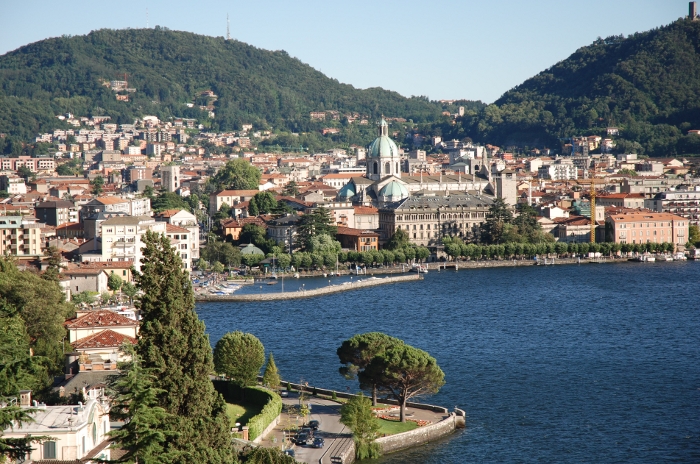
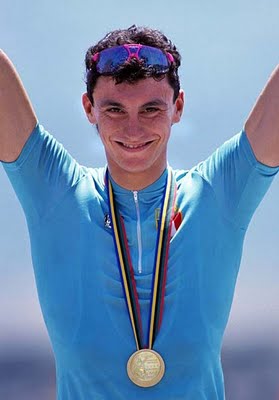
We move southwards towards Milan, which has seen the conclusion of many Giri d’Italia. This year, the Milanese will have to make do with just a TV sprint at the Duomo, and also the honour of one of its daughters being today’s Woman of the Stage.
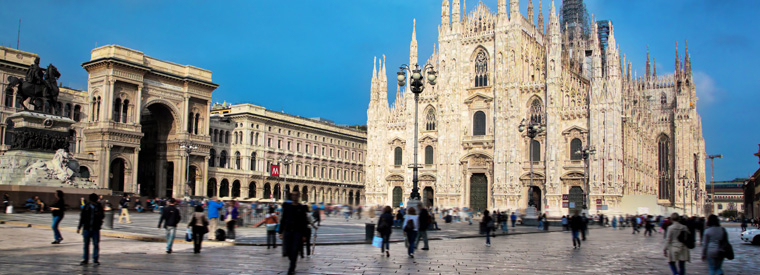
On we go through Pavia, before we explore the countryside of the Oltrepo Pavese in the southernmost tip of Lombardy. Though frequently called the Tuscany of the North of Italy the Oltrepò Pavese in Lombardy is fairly unknown abroad.
The area offer several attractions: smooth hills, medieval villages and castles, panoramic views, authentic Italian food and local wines. The Oltrepò happens to be the largest wine producing area of Lombardy and one of the largest in Italy, especially of the Pinot Nero. The landscape is scattered with vineyards that are freely accessible for hikers or even mountain biking.

We are here for the hills, and we have a number of ascents to cope with in the last 50km today. We snake through these mountains and vineyards, with three or four uncategorised climbs and a category 3 and 4 ascent. This is not to be confused with the Passo Crocetta in Liguria or in Cosenza. But it is very tough for a sprinter, with slopes of 13-14% and an average of over 9%. Riders will have 25km to get back on to the bunch to contest a bunch sprint, assuming the breakaway is not given too much leeway. And they may not be, given the paucity of remaining opportunities for our burly speedsters.
The finish will take place in Tortona, which is the town in which Fausto Coppi (Il Campionissimo) settled with his mistress Giulia Occhini (the Woman in White). His grave is a short drive outside the city.
The city is a relatively non-descript, affluent satellite town of Milan, with a rich history and an unremarkable present.
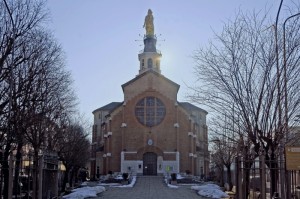
Woman of the Stage
Caterina Riario Sforza de’ Medici, was an early prototype of the type of woman that gives me the hots. OK, perhaps disemboweling one’s enemies isn’t quite the modern method of anger management. But there’s much to admire, in our postfeminist times, about the so-called “Tigress of Forlì.” Caterina was bold, brave and big-hearted; she was adroit in diplomacy and dynamic on the battlefield. Even as her own people turned on her and both papal and ducal hallways echoed with plots against her, she managed to raise a brood of healthy (if bratty) children and fend off her enemies’ intrigue. She was a controversial figure: celebrated and admired, but also reviled and feared.

In The Prince, Machiavelli highlights Sforza’s unique character. His version of her actions after Riario’s assassination in 1488 did much to promote her reputation as a sexually bold and merciless ruler. By all accounts, when Sforza entered the Rocca di Ravaldino to facilitate its surrender to the rebels, she instead mounted the ramparts with the intention to rule and challenged her enemies to kill her children, who were hostages. According to Machiavelli, in the Discourses, she then lifted her skirts to reveal her genitals, a gesture meant to emphasize her claim that she could bear more children, who would eventually avenge Riario’s murder. This purported act is an exaggeration of her actions, but this version of the events remains influential as part of her legend.
Born in 1463, Caterina was the illegitimate child of Galeazzo Maria Sforza, heir to the duchy of Milan, but she lived in unparalleled luxury. Eager to unite the papal family to the duchy of Milan, Caterina’s father offered his 10-year-old daughter as a bride to 30-year-old Girolamo Riario, a debauched military man who happened to be the pope’s nephew. His marriage hastily consummated, Girolamo departed for Rome, leaving his bride to her father’s care for the next three years. It was only after her father was assassinated that 13-year-old Caterina was packed off to join her husband.
By 1482, the states of Italy were engulfed in war, and Caterina found herself humiliated by her husband’s shameful cowardice, as captain of the papal armies, in failing to defend Rome. Instead, he “whiled away the days playing dice with his soldiers on the high altar of the cathedral.” Now Caterina realised that despite her husband’s “ornately trimmed garments, nothing of substance existed within.”
While her husband was ill, Caterina was barred from one of Forlì’s most important fortresses. Despite being pregnant, she plotted the murder of the castle’s keeper and recaptured this prize. By the time her husband was assassinated, she was busy governing Forlì and fending off kidnappers and traitors. During one siege on her fortress, “the Venetian ambassador, floored by her audacity” when confronted by the spears and daggers aimed at her children, her sister and her mother, called her a tigress, “willing to eat her young to gain power.”
She was also, apparently, a tigress in love. Falling for Giacomo Feo, a glorified stable boy, she had him knighted, secretly married him and bore his child. Blinded by her passion, she ignored signs of growing unrest among her people — and the jealousy of her oldest son. When Feo was murdered, the sight of his mutilated corpse drove Caterina to systematic vengeance: 38 people were killed, and many others were tortured, exiled or imprisoned in a ruthless, coldblooded rampage.
Caterina was also involved in a plot and tried to poison Pope Alexander VI. Caterina was then captured and imprisoned in Castel Sant' Angelo for one year. Catarina died in 1509 at the age of 46. Renaissance men referred to Caterina as "the Virago," or women warrior, for all her accomplishments.
Munch for the Bunch
We are in Lombardy. I don’t care if there are four hard days ahead for the peloton. Riders are going to be given a plate of Risotto Milanese and Osscbucco. Risotto Milanese is risotto infused with saffron. And it is a traditional accompaniment to osso bucco. Osso bucco is a Milanese speciality of cross-cut veal shanks braised with vegetables, white wine and broth. Cooked slowly, it should fall apart if you even look at it.

Absolutely delicious.
10 second penalty for anybody not finishing their dinner!
Stage 17 Como to Tortona 191km
So we are well into our third week of the centenary Giro d’Italia, aka Giro di Barmaher, in honour of its illustrious overlord. We start from Como in Lombardy, and our route goes north to south through Lombardy, before finishing in Tortona (home of Coppi) in Piemonte.
This is a transitional stage, no other way of looking at it. And it is the best chance for the sprinters. But rather than making a beeline straight for Tortona, we are going to make our way through the Olrepo Pavese, for some nice scenery and some climbs to break up the bunch before a reduced brunch sprint.
Climbs
Cat 4 Rocca di Giorgi. 549m altitude. 5.8km @ 5%.
Cat 3 Passo Crocetta. 547m altitude. 3.6km @ 9.5%.
The riders will roll out from Como, the birthplace of Fabio Casartelli (RIP). His death was absolutely tragic, and I can’t believe it was over 20 years ago. One good thing to come from this is the rule that now forces all riders to wear a helmet when racing.


We move southwards towards Milan, which has seen the conclusion of many Giri d’Italia. This year, the Milanese will have to make do with just a TV sprint at the Duomo, and also the honour of one of its daughters being today’s Woman of the Stage.

On we go through Pavia, before we explore the countryside of the Oltrepo Pavese in the southernmost tip of Lombardy. Though frequently called the Tuscany of the North of Italy the Oltrepò Pavese in Lombardy is fairly unknown abroad.
The area offer several attractions: smooth hills, medieval villages and castles, panoramic views, authentic Italian food and local wines. The Oltrepò happens to be the largest wine producing area of Lombardy and one of the largest in Italy, especially of the Pinot Nero. The landscape is scattered with vineyards that are freely accessible for hikers or even mountain biking.

We are here for the hills, and we have a number of ascents to cope with in the last 50km today. We snake through these mountains and vineyards, with three or four uncategorised climbs and a category 3 and 4 ascent. This is not to be confused with the Passo Crocetta in Liguria or in Cosenza. But it is very tough for a sprinter, with slopes of 13-14% and an average of over 9%. Riders will have 25km to get back on to the bunch to contest a bunch sprint, assuming the breakaway is not given too much leeway. And they may not be, given the paucity of remaining opportunities for our burly speedsters.
The finish will take place in Tortona, which is the town in which Fausto Coppi (Il Campionissimo) settled with his mistress Giulia Occhini (the Woman in White). His grave is a short drive outside the city.
The city is a relatively non-descript, affluent satellite town of Milan, with a rich history and an unremarkable present.

Woman of the Stage
Caterina Riario Sforza de’ Medici, was an early prototype of the type of woman that gives me the hots. OK, perhaps disemboweling one’s enemies isn’t quite the modern method of anger management. But there’s much to admire, in our postfeminist times, about the so-called “Tigress of Forlì.” Caterina was bold, brave and big-hearted; she was adroit in diplomacy and dynamic on the battlefield. Even as her own people turned on her and both papal and ducal hallways echoed with plots against her, she managed to raise a brood of healthy (if bratty) children and fend off her enemies’ intrigue. She was a controversial figure: celebrated and admired, but also reviled and feared.

In The Prince, Machiavelli highlights Sforza’s unique character. His version of her actions after Riario’s assassination in 1488 did much to promote her reputation as a sexually bold and merciless ruler. By all accounts, when Sforza entered the Rocca di Ravaldino to facilitate its surrender to the rebels, she instead mounted the ramparts with the intention to rule and challenged her enemies to kill her children, who were hostages. According to Machiavelli, in the Discourses, she then lifted her skirts to reveal her genitals, a gesture meant to emphasize her claim that she could bear more children, who would eventually avenge Riario’s murder. This purported act is an exaggeration of her actions, but this version of the events remains influential as part of her legend.
Born in 1463, Caterina was the illegitimate child of Galeazzo Maria Sforza, heir to the duchy of Milan, but she lived in unparalleled luxury. Eager to unite the papal family to the duchy of Milan, Caterina’s father offered his 10-year-old daughter as a bride to 30-year-old Girolamo Riario, a debauched military man who happened to be the pope’s nephew. His marriage hastily consummated, Girolamo departed for Rome, leaving his bride to her father’s care for the next three years. It was only after her father was assassinated that 13-year-old Caterina was packed off to join her husband.
By 1482, the states of Italy were engulfed in war, and Caterina found herself humiliated by her husband’s shameful cowardice, as captain of the papal armies, in failing to defend Rome. Instead, he “whiled away the days playing dice with his soldiers on the high altar of the cathedral.” Now Caterina realised that despite her husband’s “ornately trimmed garments, nothing of substance existed within.”
While her husband was ill, Caterina was barred from one of Forlì’s most important fortresses. Despite being pregnant, she plotted the murder of the castle’s keeper and recaptured this prize. By the time her husband was assassinated, she was busy governing Forlì and fending off kidnappers and traitors. During one siege on her fortress, “the Venetian ambassador, floored by her audacity” when confronted by the spears and daggers aimed at her children, her sister and her mother, called her a tigress, “willing to eat her young to gain power.”
She was also, apparently, a tigress in love. Falling for Giacomo Feo, a glorified stable boy, she had him knighted, secretly married him and bore his child. Blinded by her passion, she ignored signs of growing unrest among her people — and the jealousy of her oldest son. When Feo was murdered, the sight of his mutilated corpse drove Caterina to systematic vengeance: 38 people were killed, and many others were tortured, exiled or imprisoned in a ruthless, coldblooded rampage.
Caterina was also involved in a plot and tried to poison Pope Alexander VI. Caterina was then captured and imprisoned in Castel Sant' Angelo for one year. Catarina died in 1509 at the age of 46. Renaissance men referred to Caterina as "the Virago," or women warrior, for all her accomplishments.
Munch for the Bunch
We are in Lombardy. I don’t care if there are four hard days ahead for the peloton. Riders are going to be given a plate of Risotto Milanese and Osscbucco. Risotto Milanese is risotto infused with saffron. And it is a traditional accompaniment to osso bucco. Osso bucco is a Milanese speciality of cross-cut veal shanks braised with vegetables, white wine and broth. Cooked slowly, it should fall apart if you even look at it.

Absolutely delicious.
10 second penalty for anybody not finishing their dinner!
Attachments
- Feb 20, 2010
- 33,095
- 15,343
- 28,180
I'm with barmaher - the fact my killer stages were 13, 14 and 15 means that my last week is not going to be killer enough to win this.
Finn - Stelvio was intended as an MTF in 1965 (they had to finish a bit further down the mountain due to weather) and I believe was used as one in the 70s (Fuente's list of victories includes one on the Stelvio); if you wanted to be obtuse, Mara Abbott won there in 2010, but certainly 2012 finishing there was the first in generations.
Finn - Stelvio was intended as an MTF in 1965 (they had to finish a bit further down the mountain due to weather) and I believe was used as one in the 70s (Fuente's list of victories includes one on the Stelvio); if you wanted to be obtuse, Mara Abbott won there in 2010, but certainly 2012 finishing there was the first in generations.
- Aug 21, 2015
- 380
- 0
- 9,280
Yeah I can't stand the zoom and street view buttons in the bottom right hand corner on Cronoescalada. I end up just opening another tab of google maps and just look at that if I have to zoom anywhere with my laptop.
- Feb 18, 2015
- 13,828
- 9,830
- 28,180
100th GIRO D'ITALIA stage 17: Susa - Pinerolo (247 km)
First of all I am sorry for the bad looking profile but sometimes Cronoescalada manages to completely *** up a profile.


Second stage in the alps and the next monster. This time its not number of climbs but rather the length of the stage, although that ofc doesn't mean that the climbs are easy. The stage starts in Susa, a town which maybe isnt that famous but very important for cycling because there is a high number of climbs starting there, like the Colle Finestre, the Col du Mont Cenis and actually also the north side of sestriere. Its located in the Val di Susa a valley with one great feature, I use in this stage. There are two big roads going through the valley, so you can make a stage which goes through the valley twice without using one street in both directions. First up the riders ride eastwards in the direction of Torino. However, before the riders arrive in Torino they make a turn and face the first two climbs of the stage, the Colle del Lys and the Monti. The first one isnt that steep but very long and there are some very steep sections near the end of the climb, so its arguably 1st category. Monti is way steeper with numerous stretches of over 10% but its not as long. I wasnt sure if its 1st or 2nd category and to be honest I also don't know anymore why I decided that its only 2nd cat. The descent is very technical but I don't think the pace down there would be very high, because the finish is still far away. However after these two climbs we will know how the break of the day looks like and considering how hard these two ascents are the break should be very strong. It also should be big because otherwise they might have problems to increase their advantage on the following flat section. This longest flat part of the race goes into the Val di Susa and finishes in Susa which doesnt only host the start but also the only intermediate sprint of the day. From now on the stage gets extremely difficult. Firstly the riders have to go up to Moncenisio, a climb which was part of a giro stage in 2009 which also finished in Pinerolo.

This stage in 2009 used Sestriere as the penultimate climb but I have already used Sestriere yesterday so ofc my penultimate climb is another one, the Colle delle Finestre. This epic peace of tarmac and sterrato is my absolutely favorite climb. 18.5 kilometers of climbing with an average elevation gain of 9.2% and if that wouldnt be enough the second half is a gravel road. No question, this is one of the hardest climbs in cycling one of the most scenic ones and although it has only been used 3 times in the giro its already a legend. The Finestre was discovered in 2005 when Gilberto Simoni tried everything to win the giro and attacked on the foot of the Finestre. The race leader Paolo Savoldelli suddenly had huge problems and it seemed like he would loose his giro lead. However after a dramatic finale he managed to keep an advantage of 28 seconds over Simoni. After the top of the climb the riders have to go down a very long descent. The first 12 kilometers are very technical, on a narrow road with some hairpins. The second part is much easier on a wide road with hardly any turns. This part also is rather a false descent which means that although it always goes downhill, it is energy-sapping.


As a race designer you now have two possibilities. Either you finish directly in Pinerolo so the Colle delle Finestre is the final climb of the stage, or you use one more short but steep ascent, the Colle Pra Martino. I decided to let the riders suffer even more and put Pra Martino in. Pray Martino is very irregular. As you can see on the profile, its average gradient is only 6%, but there are short sections of 16% (!!!). These sections should blow the race apart and although this climb is only slightly over 6 km's long time gaps are guaranteed if they don't already exist since the Finestre. Last but not least the final descent is very technical again. That might cause some action especially if it rains.
The stage finishes in Pinerolo, a city with a rich cycling history. The last giro stage which finished there was the already mentioned stage in 2009 but since then there also was a tour de france stage finish in Pinerolo, won by Edvald Boasson Hagen. Another sporting event, Pinerolo hosted, were the curling competitions of the olympic games 2006...how exciting
Susa:

Pinerolo:

Hard to say how such a stage will unfold. Stage 18 wont be very hard so the riders definitely have the possibility to try a long range attack from the Finestre. However I don't think that will even be necessary to see a good stage. We shouldn't forget that stage 16 was already very hard, that the climb up to the Finestre starts after 180 kilometers, a distance a stage normally ends, and that there have already been 3 very difficult times up to this point. The riders will be exhausted and many team mates will already be spent so time gaps will appear automatically and even if only one favorite is in troubles the race will blow apart and suddenly everyone will be on its own and I can hardly imagine we wouldnt get good racing in such a situation. Another interesting factor is the false descent to the bottom of Pra Martino. Its possible that some riders come back together but as I already mentioned it. Some sections on Pra Martino are super steep, so the race will blow apart again. And before I forget it, rain could make this stage legendary. Very technical descents and a sterrato climb, that would cause pure carnage. And if the conditions are so bad that its impossible to go over the Finestre its still possible to use Sestriere instead.
First of all I am sorry for the bad looking profile but sometimes Cronoescalada manages to completely *** up a profile.


Second stage in the alps and the next monster. This time its not number of climbs but rather the length of the stage, although that ofc doesn't mean that the climbs are easy. The stage starts in Susa, a town which maybe isnt that famous but very important for cycling because there is a high number of climbs starting there, like the Colle Finestre, the Col du Mont Cenis and actually also the north side of sestriere. Its located in the Val di Susa a valley with one great feature, I use in this stage. There are two big roads going through the valley, so you can make a stage which goes through the valley twice without using one street in both directions. First up the riders ride eastwards in the direction of Torino. However, before the riders arrive in Torino they make a turn and face the first two climbs of the stage, the Colle del Lys and the Monti. The first one isnt that steep but very long and there are some very steep sections near the end of the climb, so its arguably 1st category. Monti is way steeper with numerous stretches of over 10% but its not as long. I wasnt sure if its 1st or 2nd category and to be honest I also don't know anymore why I decided that its only 2nd cat. The descent is very technical but I don't think the pace down there would be very high, because the finish is still far away. However after these two climbs we will know how the break of the day looks like and considering how hard these two ascents are the break should be very strong. It also should be big because otherwise they might have problems to increase their advantage on the following flat section. This longest flat part of the race goes into the Val di Susa and finishes in Susa which doesnt only host the start but also the only intermediate sprint of the day. From now on the stage gets extremely difficult. Firstly the riders have to go up to Moncenisio, a climb which was part of a giro stage in 2009 which also finished in Pinerolo.

This stage in 2009 used Sestriere as the penultimate climb but I have already used Sestriere yesterday so ofc my penultimate climb is another one, the Colle delle Finestre. This epic peace of tarmac and sterrato is my absolutely favorite climb. 18.5 kilometers of climbing with an average elevation gain of 9.2% and if that wouldnt be enough the second half is a gravel road. No question, this is one of the hardest climbs in cycling one of the most scenic ones and although it has only been used 3 times in the giro its already a legend. The Finestre was discovered in 2005 when Gilberto Simoni tried everything to win the giro and attacked on the foot of the Finestre. The race leader Paolo Savoldelli suddenly had huge problems and it seemed like he would loose his giro lead. However after a dramatic finale he managed to keep an advantage of 28 seconds over Simoni. After the top of the climb the riders have to go down a very long descent. The first 12 kilometers are very technical, on a narrow road with some hairpins. The second part is much easier on a wide road with hardly any turns. This part also is rather a false descent which means that although it always goes downhill, it is energy-sapping.


As a race designer you now have two possibilities. Either you finish directly in Pinerolo so the Colle delle Finestre is the final climb of the stage, or you use one more short but steep ascent, the Colle Pra Martino. I decided to let the riders suffer even more and put Pra Martino in. Pray Martino is very irregular. As you can see on the profile, its average gradient is only 6%, but there are short sections of 16% (!!!). These sections should blow the race apart and although this climb is only slightly over 6 km's long time gaps are guaranteed if they don't already exist since the Finestre. Last but not least the final descent is very technical again. That might cause some action especially if it rains.
The stage finishes in Pinerolo, a city with a rich cycling history. The last giro stage which finished there was the already mentioned stage in 2009 but since then there also was a tour de france stage finish in Pinerolo, won by Edvald Boasson Hagen. Another sporting event, Pinerolo hosted, were the curling competitions of the olympic games 2006...how exciting
Susa:

Pinerolo:

Hard to say how such a stage will unfold. Stage 18 wont be very hard so the riders definitely have the possibility to try a long range attack from the Finestre. However I don't think that will even be necessary to see a good stage. We shouldn't forget that stage 16 was already very hard, that the climb up to the Finestre starts after 180 kilometers, a distance a stage normally ends, and that there have already been 3 very difficult times up to this point. The riders will be exhausted and many team mates will already be spent so time gaps will appear automatically and even if only one favorite is in troubles the race will blow apart and suddenly everyone will be on its own and I can hardly imagine we wouldnt get good racing in such a situation. Another interesting factor is the false descent to the bottom of Pra Martino. Its possible that some riders come back together but as I already mentioned it. Some sections on Pra Martino are super steep, so the race will blow apart again. And before I forget it, rain could make this stage legendary. Very technical descents and a sterrato climb, that would cause pure carnage. And if the conditions are so bad that its impossible to go over the Finestre its still possible to use Sestriere instead.
- Jun 24, 2013
- 3,548
- 1,079
- 16,680
Giro d'Italia - Stage 17: Genoa - San Remo (197 km)

After already honouring il Lombardia now it's time to honour Italy's other monument: la Primavera. We won't start in Milano but in Genoa and join the classic route to San Remo in Varazze after two hard climbs. This is because I want this to be ridden more like a classic than a pure sprinters stage.

First off those two climbs is the Passo del Faiallo which starts right before the Turchino tunnel (my route goes up the side of Turchino that is descended in Milano - San Remo). The Faiallo is quickly followed by Monte Beigua. These two combine for quite a hard start with the main goal to tire out the legs of the domestiques for later on.
From Varazze on we'll follow the normal route along the coast. With about 100 km to go the riders will have to climb La Manie. A climb which I'm very fond of cause it has bettered the racing in San Remo since it's introduction (think 2008 or 2011 when the pack splitted and never came back again).
Then further on the road are the three Capi's (Melo, Cerva and Berta) before Cipressa and Poggio. Don't think I have to tell you much about these. Instead I'll share my favourite moment on both Cipressa and Poggio. My favourite Cipressa moment is one that is underrated I think cause it was not decisive (like Colombo's 1996 attack) but was just as impressive in my opinion. It's Scarponi jumping from the peloton 2 to peloton 1 in 2011 something i'll never forget. Then my favourite Poggio moment is a funny one. Don't remember the year exactly but Fornaciari was going all out early on the hill when he went way too fast in a corner and rode through an open gate into a local's courtyard. Since then this gate has been closed every year!
Finishline will be ofcourse on the Via Roma which I'll honour with a pic off the Cannibal himself. (Have not mentioned him much in my Giro so far unfortunately).
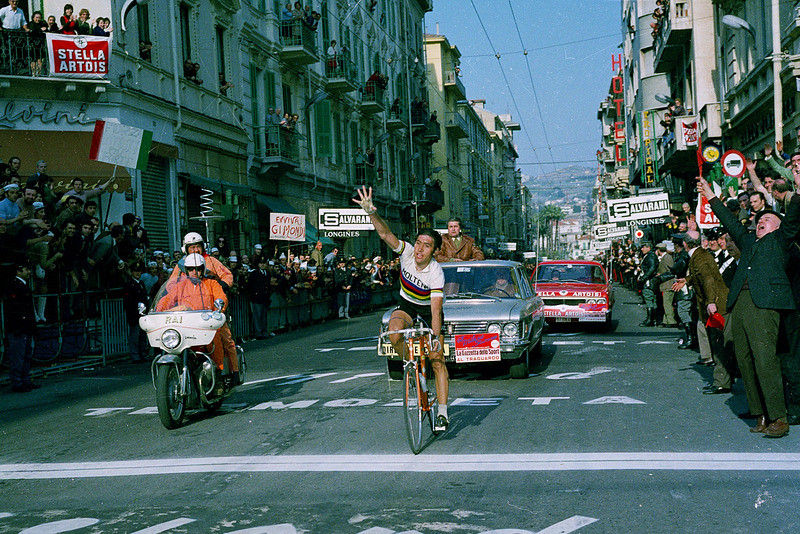

After already honouring il Lombardia now it's time to honour Italy's other monument: la Primavera. We won't start in Milano but in Genoa and join the classic route to San Remo in Varazze after two hard climbs. This is because I want this to be ridden more like a classic than a pure sprinters stage.

First off those two climbs is the Passo del Faiallo which starts right before the Turchino tunnel (my route goes up the side of Turchino that is descended in Milano - San Remo). The Faiallo is quickly followed by Monte Beigua. These two combine for quite a hard start with the main goal to tire out the legs of the domestiques for later on.
From Varazze on we'll follow the normal route along the coast. With about 100 km to go the riders will have to climb La Manie. A climb which I'm very fond of cause it has bettered the racing in San Remo since it's introduction (think 2008 or 2011 when the pack splitted and never came back again).
Then further on the road are the three Capi's (Melo, Cerva and Berta) before Cipressa and Poggio. Don't think I have to tell you much about these. Instead I'll share my favourite moment on both Cipressa and Poggio. My favourite Cipressa moment is one that is underrated I think cause it was not decisive (like Colombo's 1996 attack) but was just as impressive in my opinion. It's Scarponi jumping from the peloton 2 to peloton 1 in 2011 something i'll never forget. Then my favourite Poggio moment is a funny one. Don't remember the year exactly but Fornaciari was going all out early on the hill when he went way too fast in a corner and rode through an open gate into a local's courtyard. Since then this gate has been closed every year!
Finishline will be ofcourse on the Via Roma which I'll honour with a pic off the Cannibal himself. (Have not mentioned him much in my Giro so far unfortunately).

TRENDING THREADS
-
 Teams & Riders The Remco Evenepoel is the next Eddy Merckx thread
Teams & Riders The Remco Evenepoel is the next Eddy Merckx thread- Started by DNP-Old
- Replies: 36K
-
 Teams & Riders Tadej Pogačar discussion thread
Teams & Riders Tadej Pogačar discussion thread- Started by Lequack
- Replies: 41K
-
Teams & Riders The Great Big Cycling Transfers, Extensions, and Rumours Thread
- Started by RedheadDane
- Replies: 13K
-
-
Teams & Riders Everybody needs a little bit of Roglstomp in their lives
- Started by johnymax
- Replies: 23K
-
-
 Teams & Riders Jonas Vingegaard thread: Love in Iberia
Teams & Riders Jonas Vingegaard thread: Love in Iberia- Started by Samu Cuenca
- Replies: 10K
Latest posts
-
-
-
New Jerseys - 2026 Season - TeamKits-Maillots-Tricots-Tenues
- Latest: Armchair Cyclist
-
-
-

Cyclingnews is part of Future plc, an international media group and leading digital publisher. Visit our corporate site.
© Future Publishing Limited Quay House, The Ambury, Bath BA1 1UA. All rights reserved. England and Wales company registration number 2008885.


